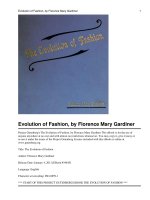Fashion slides oct9th
Bạn đang xem bản rút gọn của tài liệu. Xem và tải ngay bản đầy đủ của tài liệu tại đây (6.97 MB, 50 trang )
<span class="text_page_counter">Trang 1</span><div class="page_container" data-page="1">
The History of Fashion
“I saw it in the window and just had to have it!”
<small>•“Went With the Wind Dress” </small>
<small>•</small> <sub>Designed by Bob Mackie for the Carol Burnett </sub><small>show, 1976 </small>
<b><small>Now in the collection of Entertainment History </small></b>
</div><span class="text_page_counter">Trang 2</span><div class="page_container" data-page="2">Questions to leave with:
</div><span class="text_page_counter">Trang 3</span><div class="page_container" data-page="3">Rome
• The ideals of fashion as they were in classical times in Ancient Egypt, Greece, and Rome. We will look to see how these ideals carry-on through the ages
</div><span class="text_page_counter">Trang 4</span><div class="page_container" data-page="4">Crossover: Fashion and Art
<i>The Golden Age of Couture: Paris and London 1947-1957 </i>
</div><span class="text_page_counter">Trang 5</span><div class="page_container" data-page="5">May 4–August 7, 2011
</div><span class="text_page_counter">Trang 6</span><div class="page_container" data-page="6">Terms with which to describe fashion: Four Elements of Design
• Line
• Form/Silhouette • Color
• Texture
</div><span class="text_page_counter">Trang 7</span><div class="page_container" data-page="7">Silhouette or Shape
</div><span class="text_page_counter">Trang 8</span><div class="page_container" data-page="8">
Silhouettes
</div><span class="text_page_counter">Trang 9</span><div class="page_container" data-page="9">Silhouettes and style lines
</div><span class="text_page_counter">Trang 10</span><div class="page_container" data-page="10">Underwear often is the most important element in creating the silhouette
</div><span class="text_page_counter">Trang 11</span><div class="page_container" data-page="11">Color Wheel
</div><span class="text_page_counter">Trang 12</span><div class="page_container" data-page="12">Textures speak volumes about people/characters
<small>•</small> <i><b><small>Hyacinthe Richaud, Louis in Robes of State, 1701 </small></b></i>
<small>•</small> <i><b><small>Anthony Van Dyck, Charles I at the Hunt, 1635 </small></b></i>
<small>•</small> <i><b><small>Piero della Francesca, Federico da Montefeltro, </small></b></i>
</div><span class="text_page_counter">Trang 13</span><div class="page_container" data-page="13">The elegance, simplicity, balance, and attention to the human form begins
with the ancients….
</div><span class="text_page_counter">Trang 14</span><div class="page_container" data-page="14">Through their attention to silhouette, line, color, and texture, we begin our story of the history of fashion
</div><span class="text_page_counter">Trang 15</span><div class="page_container" data-page="15">Basic Egyptian clothing styles 3000 BC-30AD
<small>•</small> <sub>Clothing said to be: roomy, light, and spare. </sub>
<small>•</small> <sub>Men and women: </sub><small>•</small> <sub>Loincloths; </sub>
<small>•</small> <sub>wrap around skirts= </sub><small>shenti </small>
<small>•robes/longer </small>
<small>garments—made of rectangular lengths of cloth </small>
<small>•Cloaks and long and short •</small> <sub>Garments made of </sub>
<small>shawls-squares and </small>
<small>rectangles of fabric •Sashes and straps •sandals </small>
<small>• kalasiris or Calasiris= sheath dress </small>
</div><span class="text_page_counter">Trang 16</span><div class="page_container" data-page="16">Kalasiris/Calasiris or bead-net sheath dress
Statue of an Offering Bearer, Metropolitan Museum Skills include: beading; pattern weaving, embroidery, applique
Beadnet dress MFA Boston 2323–2150 B.C.
constructed of: faience cylinder beads, reconstructed
</div><span class="text_page_counter">Trang 17</span><div class="page_container" data-page="17"><small>Wooden statue of the Lady Thuya, 1570-1320 B.B. </small>
1330 BC
Pyramids at Giza, 2540
</div><span class="text_page_counter">Trang 18</span><div class="page_container" data-page="18">Shenti/loincloth
Old
Kingdom
Middle Kingdom
New Kingdom
Late Period
Attention given to the genital area in men’s clothing was due to the fact it was regarded as sacred because of its involvement in procreation
</div><span class="text_page_counter">Trang 19</span><div class="page_container" data-page="19">Watercolor by Henry Salt of a painted relief in the early 19<small>th</small> Dynasty tomb of Sety I.
Standard symbols used include: water plants, lotus, papyrus, scarab, and the sun disc (Aton) Cobra head= Uraeus signified the Pharoah
</div><span class="text_page_counter">Trang 20</span><div class="page_container" data-page="20"><b>18th Dynasty </b>
1370BC
Nebamun’s tomb, musicians and dancers,
frontal view of faces With after dinner coned
head melts
</div><span class="text_page_counter">Trang 21</span><div class="page_container" data-page="21">Shenti in pyramid shapes & an assortment of headdresses— later Egyptian history
looms that wove ornamental tapestry and patterned fabric date from 1500 BC
</div><span class="text_page_counter">Trang 22</span><div class="page_container" data-page="22">Collar / Mantle: gold, carnelian, glass Wide collar= Mantle
Horus= falcon God, protector of Egyptian Pharoah
Collars could be made from: Shells
Beads Flowers
Precious stones set into gold Worn as necklace or set
attached to leather or cloth neckline
Extended over the neck an d shoulders, nine rows of inlaid beads, on each side is a falcon head
Reign of Tut, 18<small>th</small> dynasty
Egyptians believed in magic: that by representing religious figures in jewelry, the positive quality of the deity would be transferred to the wearer
</div><span class="text_page_counter">Trang 23</span><div class="page_container" data-page="23">King Tut’s pectoral
sun/ protective vulture wings/ uraeus or cobra/ scarab: symbol of life and the solar cycle
Two most prominent types of jewelry: pectoral and collar Weighted in back with counterweight
</div><span class="text_page_counter">Trang 24</span><div class="page_container" data-page="24">• linen shirt, about 1360 BC • Victoria and Albert
Museum
Pleated tunic. 1st dynasty, c. 3100-2890 BC.
Petrie Museum, London Linen tunic
over four thousand years old. The Petrie Museum of Egyptian Archaeology.
</div><span class="text_page_counter">Trang 25</span><div class="page_container" data-page="25">wears the blue crown= Khepresh or called “War Crown”
• Nefertiti: “A Beautiful Woman has Come”
• Ruled with
Akhenaton, his reign: 1352 BC-1336 BC • Life: ~1367-1336 BC
Nefertiti C 1350
</div><span class="text_page_counter">Trang 26</span><div class="page_container" data-page="26">Pyramids at Giza
</div><span class="text_page_counter">Trang 27</span><div class="page_container" data-page="27">What is Classical beauty?
Audrey Hepburn, 1961
Eiizabeth Taylor as Cleopatra, 1963
</div><span class="text_page_counter">Trang 28</span><div class="page_container" data-page="28">Nemes head-dress
King Tut’s, about 1350 B.C.
Khat or Klaft headdress
</div><span class="text_page_counter">Trang 29</span><div class="page_container" data-page="29">Wedjat eye= the Eye of Horus
the symbol of healing and protection
Worn to protect from: Sun; insect disease; sand
Protective amulet. Worn as a popular good luck charm.
</div><span class="text_page_counter">Trang 30</span><div class="page_container" data-page="30"><small>Image of Elizabeth Taylor for Cleopatra, 1963 </small>
</div><span class="text_page_counter">Trang 31</span><div class="page_container" data-page="31">Egypt inspires Art Deco, 1925-
1939
</div><span class="text_page_counter">Trang 32</span><div class="page_container" data-page="32">Comparison of ancient statuary: body ideals
King Mycerinus and
His Queen 2548-2530 B.C.E.
<b>Statue of a </b>
<b>kouros (youth), </b>
ca. 590–580 B.C. Archaic
<i><b><small>The Winged Victory of Samothracec. </small></b></i>
<small>220-190 BC, </small>also called the
<i><b>Nike of Samothrace, </b></i>
4<small>th</small> century BC
Kouros Late Archaic
</div><span class="text_page_counter">Trang 33</span><div class="page_container" data-page="33">Words to describe Greek ideals exhibited in art and fashion…
• Interest in uniting motion and human emotion • Ease of movement
• Deeply felt poetry of being
• Animated with an inner life force
</div><span class="text_page_counter">Trang 34</span><div class="page_container" data-page="34">Ancient Greece: 800 BC-146 AD
admiration for the human form guided dress
4th century BC <small>Parthenon, Three goddesses Hestia, Dione, Aphrodite) from the east </small>
<small>pediment, 438-432 BC. </small>
Greatest temple: The Parthenon built 448-432 Ionic Chiton
</div><span class="text_page_counter">Trang 35</span><div class="page_container" data-page="35">Colors could have included: red, blue,
yellow, and green Textiles could have
patterns of: • <sub>Stylized floral </sub>
been: woven Embroidered
painted
</div><span class="text_page_counter">Trang 36</span><div class="page_container" data-page="36">Chiton:
Doric (450-300BC) Ionic (550-300 BC) ; Hellenistic (300-100 BC) Nike of Samothrace, 190 BC
</div><span class="text_page_counter">Trang 37</span><div class="page_container" data-page="37">Charioteer’s chiton(ky’tn)= xystis. His shoulders are seamed
variations from: belting; fold at the top; varying placement of the pins soft, thin linen cloth compressed with belt into soft columnar folds. Fabric
often pleated
</div><span class="text_page_counter">Trang 38</span><div class="page_container" data-page="38">The Doric Chiton or Doric Peplos
5
thand 6
thcenturies B.C.
</div><span class="text_page_counter">Trang 40</span><div class="page_container" data-page="40"><small>Olympic Victor </small>
<small> Priest of Dionysius King </small>
<small>Priestess Noblewoman Captain </small>
<small> </small>
</div><span class="text_page_counter">Trang 41</span><div class="page_container" data-page="41">Charioteer’s headband: Greek key or Meander
</div><span class="text_page_counter">Trang 42</span><div class="page_container" data-page="42">Greek decorative borders
Could be printed, woven, or painted
Halston designs,
</div><span class="text_page_counter">Trang 43</span><div class="page_container" data-page="43">Ancient Greeks
Ancient Romans
</div><span class="text_page_counter">Trang 44</span><div class="page_container" data-page="44">Roman, 753 B.C. – A.D. 476
</div><span class="text_page_counter">Trang 45</span><div class="page_container" data-page="45">Comparison of Greek and Roman columns & men’s fashions
The Charioteer of Delphi, 478 BC, wearing a xystis Fastened with a belt and straps to keep it out of his way
</div><span class="text_page_counter">Trang 46</span><div class="page_container" data-page="46">The Toga!
Statue of Caesar Augustus,
<i>c. 30 BC-20 BC; </i>
</div><span class="text_page_counter">Trang 47</span><div class="page_container" data-page="47">The Coliseum, 70 AD
</div><span class="text_page_counter">Trang 49</span><div class="page_container" data-page="49">The Doric Column Dress, 1978/79
</div><span class="text_page_counter">Trang 50</span><div class="page_container" data-page="50">Alexander McQueen (British, 1969–2010). Dress, autumn/winter 2010–11
</div>








